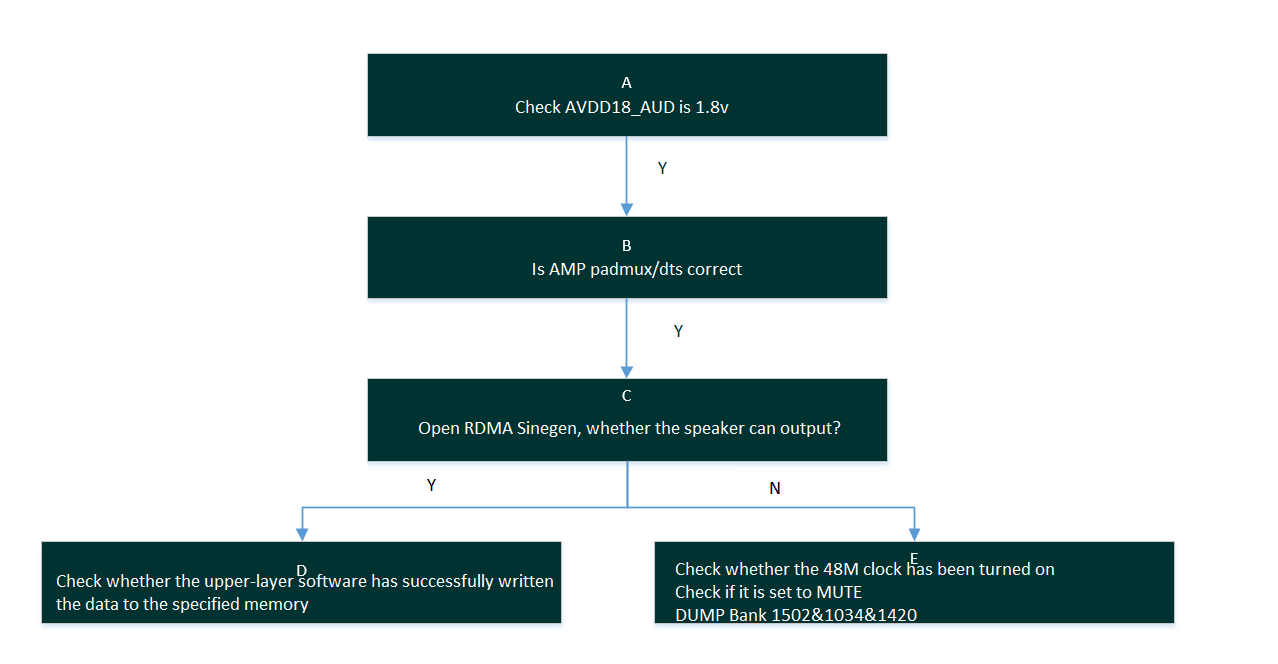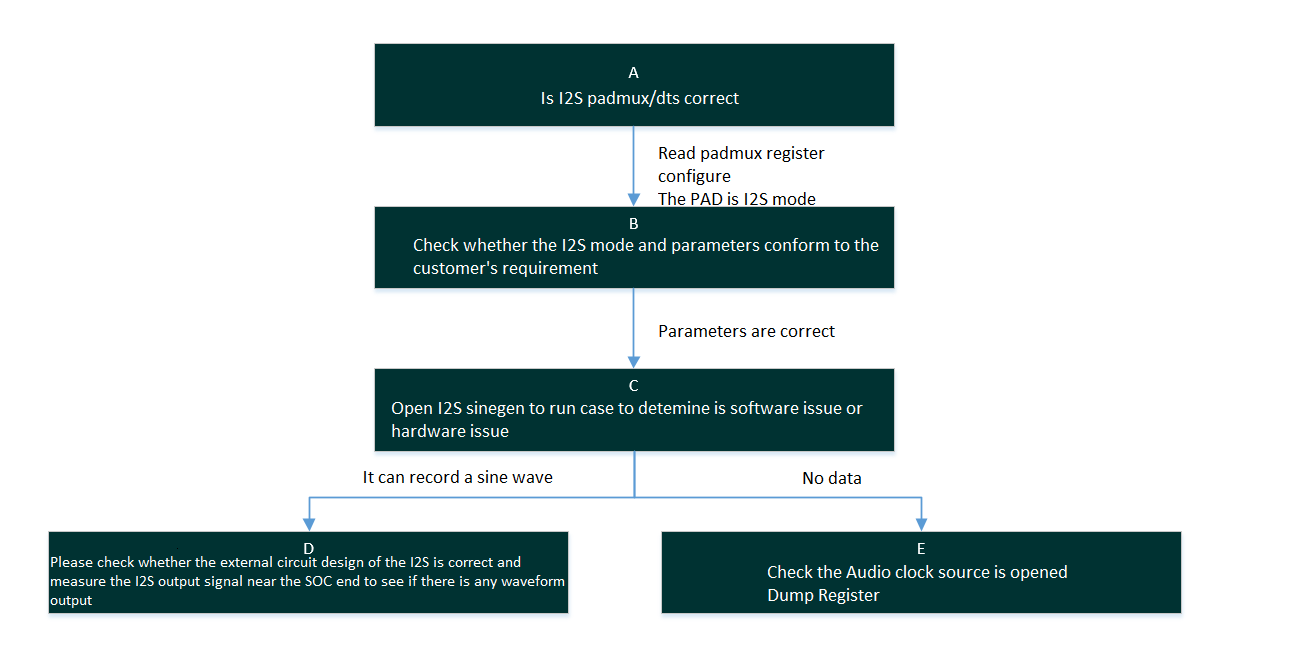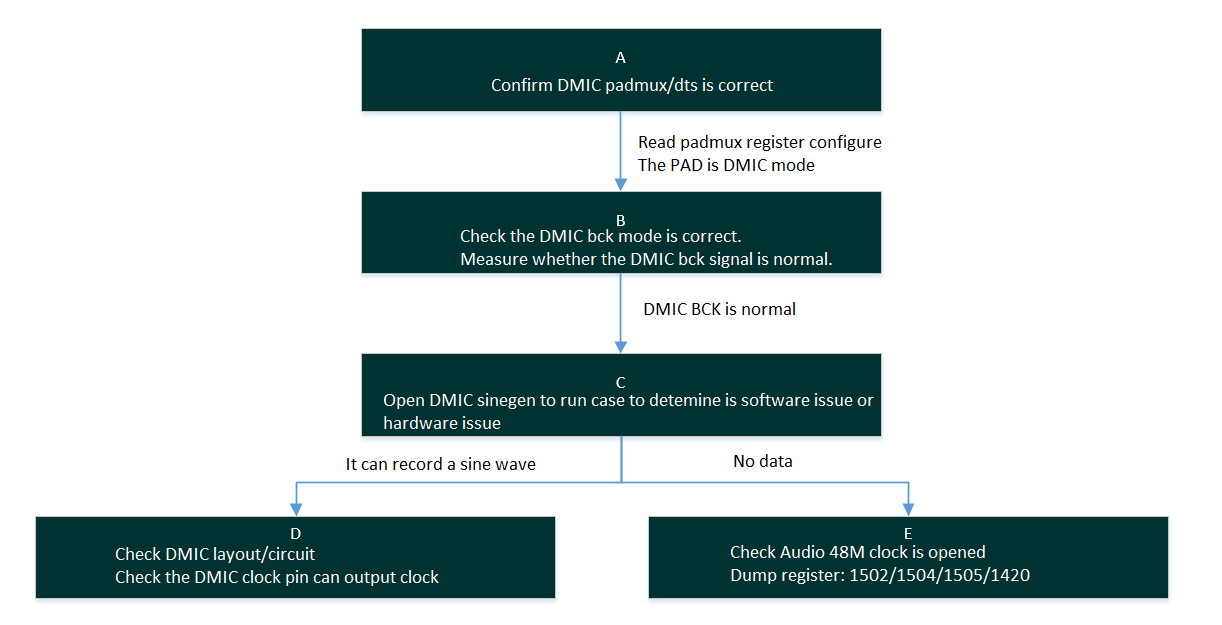Sigmastar Audio_debugsop Manual
REVISION HISTORY¶
| Revision No. | Description |
Date |
|---|---|---|
| 1.0 | 03/05/2024 |
SW RD Required Dump Information¶
1. Capture registers 1502/1503/1504/1505/1506/1034/103c/141d
2. tinymix contents information (depends on how many sound cards, use -D to set)
3. cat alsa information:
cat /proc/asound/card0/pcm0p/sub0/status
cat /proc/asound/card0/pcm0p/sub0/sw_params
cat /proc/asound/card0/pcm0p/sub0/hw_params
cat /proc/asound/card0/pcm0c/sub0/status
cat /proc/asound/card0/pcm0c/sub0/sw_params
cat /proc/asound/card0/pcm0c/sub0/hw_params
4. Device tree information: dtsi containing sound nodes, such as arch/arm64/boot/dts/sstar/pcupid.dtsi
5. padmux information: padmux.dtsi
6. LOG information: whether there are abnormal error messages
7. If dump_pcm is enabled, provide the dumped audio files (path in /tmp):
echo dump_pcm -enable 1 > /proc/audio/debug
8. Clock information:
cat /sys/kernel/debug/clk/clk_summary | grep aupll
cat /sys/kernel/debug/clk/clk_summary | grep bachpll
Issue 1. Speaker Playback is Silent¶

| Process | Method | Exit Condition |
Next Step |
Information to Provide to SWRD |
Related FAQ Reference |
|---|---|---|---|---|---|
| A | 1. During playback, use a multimeter to confirm AUDIO's AUDD18_AUD is 1.8V 2. During playback, use a multimeter to measure if PAD_AUD_VAG's voltage is greater than 0.9V |
Exit Condition 1: 1. The VDD power supply voltage of AUDIO during playback differs significantly from 1.8V, 2. The reference voltage VAG of AUDIO during playback is not greater than 0.9V > Power supply issue Exit Condition 2: Power supply is normal> No issue |
Exit Condition 1: > Process ends Exit Condition 2: > B |
Exit Condition 1: ==> Seek CAE assistance |
|
| B | 1. Confirm if the padmux configuration of AUDIO AMP PAD corresponds with the development board, and check if the pad conflicts with other modes: cd vi arch/arm64/boot/dts/sstar/pcupid_xxxx-padmux.dtsi Check if AMP PAD has been set to MDRV_PUSE_AIO_AMP_PWR mode, and use IO_Check Tool to verify if the mode is set successfully (./io_check_xxx PinID) |
Exit Condition 1: 1. padmux is not configured correctly or there is a conflict with other modes Exit Condition 2: AMP PAD configuration is normal==> No issue |
Exit Condition 1: > Process ends Exit Condition 2: > C |
Exit Condition 1: ==> Seek CAE to confirm the current padmux situation used by the development board, and configure the correct padmux and dts according to the actual situation |
|
| C | 1. Enable RDMA sinegen (echo AO_DMA_A -enable 1 > /proc/audio/sinegen) and play, check if the Speaker can play a sine wave |
Exit Condition 1: 1. Can play a sine wave audio file > Please check if the upper software successfully writes data to the specified memory Exit Condition 2: No sound output > Internal Audio exception |
Exit Condition 1: > Process ends Exit Condition 2: > Please SW RD assist in troubleshooting |
Exit Condition 1: > Please check the application logic, or refer to the provided MI_Demo to adjust the code Exit Condition 2: > Please provide required dump information |
Issue 2. AMIC Recording Has No Data¶

| Process | Method | Exit Condition |
Next Step |
Information to Provide to SWRD |
Related FAQ Reference |
|---|---|---|---|---|---|
| A | 1. During recording, use a multimeter to confirm AUDIO's AUDD18_AUD is 1.8V 2. During recording, use a multimeter to measure if PAD_AUD_VAG's voltage is greater than 0.9V |
Exit Condition 1: 1. The VDD power supply voltage of AUDIO during recording differs significantly from 1.8V, 2. The reference voltage VAG of AUDIO during recording is not greater than 0.9V > Power supply issue Exit Condition 2: Power supply is normal> No issue |
Exit Condition 1: > Process ends Exit Condition 2: > B |
Exit Condition 1: ==> Seek CAE assistance |
|
| B | 1. Check if the AMIC wiring is correct 2. After connecting the MIC, measure the MIC PIN with an oscilloscope during recording to see if there is any level change |
Exit Condition 1: 1. Check for incorrect AMIC wiring 2. After connecting the MIC, the oscilloscope measures no level change on the MIC PIN during recording > Hardware environment issue Exit Condition 2: Configuration is normal> No issue |
Exit Condition 1: > Process ends Exit Condition 2: > C |
Exit Condition 1: ==> Seek CAE assistance in troubleshooting |
|
| C | 1. Enable ADC sinegen (echo AI_DMA_A -enable 1 > /proc/audio/sinegen) and record, check if the audio file can record a sine wave or play back the recorded data in real-time, listen if the sound is a sine wave |
Exit Condition 1: 1. Can record a sine wave audio file > AMIC external circuit or layout design does not meet the specifications of the current AMIC used Exit Condition 2: No data recorded > Internal Audio exception |
Exit Condition 1: > Process ends Exit Condition 2: > Please SW RD assist in troubleshooting |
Exit Condition 1: > Seek CAE assistance in troubleshooting Exit Condition 2: > Please provide required dump information |
Issue 3. I2S Working Abnormally in Master Mode¶

| Process | Method | Exit Condition |
Next Step |
Information to Provide to SWRD |
Related FAQ Reference |
|---|---|---|---|---|---|
| A | Confirm if the padmux configuration of AUDIO I2S PAD corresponds with the development board, and check if the pad conflicts with other modes Method: cd vim arch/arm64/boot/dts/sstar/pcupid_xxxx-padmux.dtsi Check if I2S PAD has been set to MDRV_PUSE_I2S0_XX_XXX mode, and use IO_Check Tool to verify if the mode is set successfully (./io_check_xxx PinID) |
Exit Condition 1: padmux is not configured correctly or there is a conflict with other modes Exit Condition 2: I2S PAD configuration is normal ==> No issue |
Exit Condition 1: > Process ends Exit Condition 2: > B |
Exit Condition 1: Seek CAE to confirm the current padmux situation used by the development board, and configure the correct padmux and dts according to the actual situation |
pageId=62543124 |
| B | Check if the I2S mode and Format parameters meet the customer application scenario: cat /proc/audio/tdm |
Exit Condition 1: 1. Parameters do not meet customer application scenario > Parameter configuration issue Exit Condition 2: Parameters meet customer application scenario> No issue |
Exit Condition 1: > Process ends Exit Condition 2: > C |
Exit Condition 1: ==> Set reasonable parameters according to the customer's application scenario, provide dtsi containing I2S configuration |
|
| C | Test if the clock output is present: use LA/oscilloscope to capture BCK/WCK pins to see if there is output | Exit Condition 1: 1. No clock output > Hardware configuration issue Exit Condition 2: Can output clock normally> No issue |
Exit Condition 1: > Process ends Exit Condition 2: > D |
Exit Condition 1: ==> Please CAE check if there are hardware pull-up/down effects, if not, provide information to SW RD |
|
| D | Test if the clock output is correct: use LA/oscilloscope to capture BCK/WCK pins WCK = SampleRate BCK = SampleRate * channels * bits |
Exit Condition 1: Clock configuration output > Hardware configuration issue Exit Condition 2: Can output clock normally> No issue |
Exit Condition 1: > Process ends Exit Condition 2: > E |
Exit Condition 1: ==> Please CAE check if there are hardware pull-up/down effects, if not then |
|
| E | 1. Enable I2S RX sinegen (echo singen 13 1 > /proc/mi_modules/mi_ai/mi_ai0) and record; Enable RDMA Sinegen on TX side (echo singen 0 1 > /proc/mi_modules/mi_ao/mi_ao0) and play, check if the audio file can record a sine wave; measure the waveform to see if the PAD outputs normally |
Exit Condition 1: 1. Can record a sine wave audio file or PAD output waveform is normal > Please check if the I2S external circuit design is correct, disconnect the external circuit and measure if the I2S output signal near the SOC is normal Exit Condition 2: No data recorded > Internal Audio exception |
Exit Condition 1: > Process ends Exit Condition 2: > Please SW RD assist in troubleshooting |
Exit Condition 1: > Seek CAE assistance in troubleshooting Exit Condition 2: > Please provide required dump information |
pageId=62524757 |
Issue 4. DMIC Not Functioning Properly¶

| Process | Method | Exit Condition |
Next Step |
Information to Provide to SWRD |
Related FAQ Reference |
|---|---|---|---|---|---|
| A | 1. Confirm if the padmux configuration of AUDIO DMIC PAD corresponds with the development board, and check if the pad conflicts with other modes: cd vim arch/arm/boot/dts/iford_xxxx-padmux.dtsi Check if DMIC PAD has been set to MDRV_PUSE_DMIC0_XX mode, and use IO_Check Tool to verify if the mode is set successfully (./io_check_xxx PinID) |
Exit Condition 1: padmux is not configured correctly or there is a conflict with other modes Exit Condition 2: DMIC PAD configuration is normal ==> No issue |
Exit Condition 1: > Process ends Exit Condition 2: > B |
Exit Condition 1: Seek CAE to confirm the current padmux situation used by the development board, and configure the correct padmux and dts |
|
| B | 1. Check if the DMIC BCK mode and PAD pin's power supply voltage meet the customer's DMIC hardware application scenario, and measure the DMIC BCK signal during DMIC recording |
Exit Condition 1: 1. Parameters do not meet customer application scenario > Parameter configuration issue Exit Condition 2: Parameters meet customer application scenario> No issue |
Exit Condition 1: > Process ends Exit Condition 2: > C |
Exit Condition 1: ==> Set reasonable parameters according to the customer's application scenario |
|
| C | 1. Enable DMIC Sinegen (echo singen 10 1 > /proc/mi_modules/mi_ai/mi_ai0) and play, check if the audio file can record a sine wave; measure the waveform to see if the PAD outputs normally |
Exit Condition 1: 1. Can record a sine wave audio file or PAD output waveform is normal > Please check if the customer's DMIC external circuit design is correct, try increasing the driving energy of the DMIC PIN, and use an oscilloscope to measure if the hardware DMIC Data PIN outputs normally Exit Condition 2: No data recorded > Internal Audio exception |
Exit Condition 1: > Process ends Exit Condition 2: > Please SW RD assist in troubleshooting |
Exit Condition 1: > Seek CAE assistance in troubleshooting Exit Condition 2: > Please provide required dump information |
pageId=62534576 |
Issue 5. Speaker Playback Has Noise¶

| Process | Method | Exit Condition |
Next Step |
Information to Provide to SWRD |
Related FAQ Reference |
|---|---|---|---|---|---|
| A | Enable RDMA Sinegen (echo AO_DMA_A -enable 1 > /proc/audio/sinegen) and run the customer application, check if noise can still be heard |
Exit Condition 1: No noise > Upper software stream exception Exit Condition 2: Noise still exists > Further investigation needed |
Exit Condition 1: > Process ends Exit Condition 2: > B |
Exit Condition 1: Please check the application logic, or refer to the provided MI_Demo to adjust the code |
|
| B | During playback, use an oscilloscope to measure the DAC PIN output signal, observe if the waveform is normal |
Exit Condition 1: 1. Waveform is a sine wave and clean without noise, frequency is stable > External hardware interference Exit Condition 2: Waveform is distorted> Internal Audio state exception |
Exit Condition 1: > Process ends Exit Condition 2: > C |
Exit Condition 1: ==> Please check if the external hardware circuit/reference voltage source is introducing signal interference, or if there is crosstalk introduced by a load (voltage regulator chip) |
|
| C | Enable AMIC Sinegen (echo AI_DMA_A -enable 1 > /proc/audio/sinegen) and record, check if the waveform is normal |
Exit Condition 1: 1. Can record a sine wave audio file or PAD output waveform is normal > Analog clock source is stable, ruling out clock instability issues, only DAC has exceptions 2. Waveform is abnormally distorted> Clock source is unstable or analog circuit is abnormal ==> Internal Audio exception |
Exit Condition 1: ==> Process ends |
Exit Condition 1: ==> D |
pageId=62524755 |
| D | 1. Check if Aupll is enabled cat /sys/kernel/debug/clk/clk_summary to see if CLK_aupll_384M is enabled |
Exit Condition 1: Audio 48M clock is not turned on > Clock configuration issue Exit Condition 2: Audio 48M clock is normal > Internal Audio exception |
Exit Condition 1: 1. Process ends Exit Condition 2: 1. Process ends |
Exit Condition 1: Need CLK Owner to assist in troubleshooting Exit Condition 2: ==> E |
pageId=62546055 |
| E | Check if the DUMP audio data is normal echo dump_pcm -enable 1 > /proc/audio/debug generate files in /tmp |
Exit Condition 1: Data is abnormal > Internal Audio exception Exit Condition 2: Data is normal > Further investigation needed |
Exit Condition: Provide dump information to SW RD for analysis | Exit Condition 2: If processed by an algorithm, please seek assistance from algorithm colleagues to troubleshoot, check algorithm parameters; if not processed by an algorithm, please provide required dump information |
pageId=62546053 |
| --- |
Issue 6. Frequent Popping Noise During Playback/Recording¶

| Process | Method |
Exit Condition |
Next Step |
Information to Provide to SWRD |
Related FAQ Reference |
|---|---|---|---|---|---|
| A | Check if the Gain value configuration is reasonable, reduce the Gain value and observe if there is still popping noise |
Exit Condition 1: No popping noise > Parameter configuration issue Exit Condition 2: Popping noise exists > Further investigation needed |
Exit Condition 1: > Process ends Exit Condition 2: > B |
Exit Condition 1: Adjust Gain value to a reasonable parameter, avoid excessive Gain causing audio signal to exceed limits leading to waveform distortion |
|
| B | Enable Sinegen (echo AO_DMA_A -enable 1 > /proc/audio/sinegen) conduct tests to see if there is still popping noise |
Exit Condition 1: 1. No popping noise > Hardware issue Exit Condition 2: Popping noise still exists> Further investigation needed |
Exit Condition 1: > Process ends Exit Condition 2: > C |
Exit Condition 1: ==> Please CAE assist in troubleshooting the customer's external circuit, see if external signals are affecting |
|
| C | 1. Enable Debug printing, observe if there are multiple occurrences of DMA FULL/EMPTY; Local Buffer Empty/Full abnormal prints echo irq -enable 1 > /proc/audio/debug echo dma -enable 1 > /proc/audio/debug |
Exit Condition 1: 1. Abnormal prints exist > Further investigation needed Exit Condition 2: No abnormal prints > For playback scenarios, please CAE check if the external circuit design is correct, measure the output signal of the PIN, for recording scenarios, use DUMP PCM command for further investigation |
Exit Condition 1: > D Exit Condition 2: > G |
||
| D | 1. Please confirm if the time interval for sending and receiving data in the application is stable, whether there is a mismatch between the upper layer sending/receiving data rate and the lower layer hardware sending/receiving rate | Exit Condition 1: 1. Sending/receiving rates do not match > Rate synchronization issue Exit Condition 2: Upper layer sending/receiving data is normal > Internal Audio exception |
Exit Condition 1: > Process ends Exit Condition 2: > F |
Exit Condition 1: Please adjust the application sending/receiving rate to avoid frame loss or data playback issues |
pageId=62527548 |
| E | 1. Check if the DUMP MHAL & MI layer audio data is normal |
Exit Condition 1: 1. MHAL layer data is abnormal > Internal Audio exception Exit Condition 2: DUMP waveform is abnormal > Further investigation needed |
Exit Condition 1: > F Exit Condition 2: > G |
||
| F | 1. Check if Aupll is enabled cat /sys/kernel/debug/clk/clk_summary to see if CLK_aupll_384M is enabled |
Exit Condition 1: Audio 48M clock is not turned on > Clock configuration issue Exit Condition 2: Audio 48M clock is normal > Internal Audio exception |
Exit Condition 1: 1. Process ends Exit Condition 2: 1. Process ends |
Exit Condition 1: Need CLK Owner to assist in troubleshooting Exit Condition 2: ==> G |
pageId=62546055 |
| G | Check if the DUMP audio data is normal echo dump_pcm -enable 1 > /proc/audio/debug generate files in /tmp |
Exit Condition 1: Data is abnormal > Internal Audio exception Exit Condition 2: Data is normal > Further investigation needed |
Exit Condition: Provide dump information to SW RD for analysis | Exit Condition 2: If processed by an algorithm, please seek assistance from algorithm colleagues to troubleshoot, check algorithm parameters; if not processed by an algorithm, please provide required dump information |
pageId=62546053 |